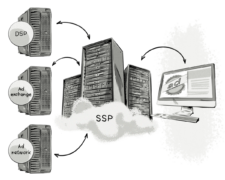The online advertising industry has faced various challenges in recent years – regulations like the GDPR, industry-wide problems like banner burn and banner blindness, as well as the increasing unreliability of cookies due to ad-blocking software and browser mechanisms like Intelligent Tracking Prevention (ITP).
Despite these issues, targeting users based on their behavior is still one of the most popular ways to reach a desired audience.
Online behavioral targeting has come a long way since its humble beginnings, becoming an incredibly advanced way for advertisers to reach their target audience. The technology connected with the collection and use of user data has allowed for the emergence of techniques like audience extension. The process allows publishers to generate more revenue from their traffic by enabling advertisers to reach their highly valued audiences outside of their websites.
Audience extension is gaining popularity, with most major digital publishers and advertising technology (AdTech) platforms offering it to their clients and partners.
The technique is beneficial for both advertisers and publishers. It allows advertisers to find bigger audiences that better match their target via a publisher’s high-quality first-party data. For publishers, audience extension allows them to efficiently monetize traffic and become more relevant for the advertisers with even more meaningful segmentation of audiences – without having to flood their own real estate with more display ads.
We Can Help You Build a Data Management Platform (DMP)
Our AdTech development teams can work with you to design, build, and maintain a custom-built data management platform (DMP) for any programmatic advertising channel.
What Is Audience Extension?
Audience extension is a process which, as the name suggests, extends digital audiences. It helps transform a publisher’s traffic into an advertiser’s audience, meaning that publishers can monetize their site traffic by allowing advertisers to reach their visitors not only on their website, but all over the web.
By increasing the reach of ads, audience extension lets advertisers prioritize quality over quantity of impressions.
Bottom line: Audience extension leads to higher conversion rates and a more efficiently spent advertising budget.
This comes down to:
- Improved lift: Campaigns can be more precisely targeted at users who better fit the advertiser’s profile of a potential customer – e.g. by their demographics and demonstrated on-site behavior – and are more likely to convert.
- Bigger reach: Instead of constantly purchasing a limited amount of inventory on a single publisher’s site, advertisers can serve their ads on other sites where their most relevant audiences are. At the same time, publishers don’t have to sell their own inventory in order to generate revenue from their valuable first-party data, meaning they can offer a completely ad-free website experience if they choose to.
What Problems Does Audience Extension Solve?
Audience extension satisfies advertisers’ voracious appetite for impressions and relevant audiences. Over the years, prioritizing quantity over quality of impressions has led to some of the key problems of programmatic ad buying: ad fraud, low ad viewability and bot traffic.
Essentially, high viewability does not always translate to better conversion rates. More and more advertisers are after lift and quality audiences.
Audience extension scales up the target audience, and reaches internet users beyond the media offered by publishers.
How Does Audience Extension Work?
Audience extension is a process which uses cookies to identify and track a user’s activity as they move from website to website – similar to retargeting.
First, a publisher’s data-management platform (DMP) creates a cookie for each new visitor and assigns them a cookie ID. Then, the DMP syncs that cookie ID with supply-side platforms (SSPs), ad exchanges, and demand-side platforms (DSPs), so that when the user visits a different website, they are able to be identified. From there, advertisers can serve ads to this user on the different websites they visit.
A DMP Is the Beating Heart of Audience Extension
The piece of technology central to audience extension is a DMP, which is used by publishers to collect data about their website visitors and create audience segments.
The audience segments that a DMP creates can be synced with SSPs and DSPs, or exchanged in a direct relationship between an advertiser and publisher.
Essentially, audience extension allows publishers to create segments that are ready to be used by advertisers. This is useful for advertisers wanting to display ads to users who have demonstrated an interest in a certain topic, service or geographical location.
Let’s take a look at how a publisher can use a DMP to improve revenue on their inventory and then how a DMP can be used for audience extension.
How Publishers Can Improve Inventory Revenue With a DMP

The publisher sends their first-party data to a DMP and creates audience profiles (aka segments), which can also consist of third-party data. The publisher’s SSP connects to the DMP, which allows the publisher to pass on information about their audiences to advertisers. If the information about the user matches an advertiser’s campaign, they’ll send back a bid. If they win the bid, their ad is displayed to the user.
The DMP, SSP and DSP all perform cookie syncing or use an ID solution to identify the user and determine which audience they belong to.
We explain what cookie syncing is and how it works in one of our previous posts.
How Publishers Can Perform Audience Extension With a DMP

With audience extension, the publisher in the first example (luxury-watches.com) would create audience segments in a DMP and make them available to advertisers across different websites. By making their audiences available to advertisers, publishers can also help them target visitors similar to the publisher’s actual audience via look-alike modeling and audience expansion.
What User Data Is Included in Audience Segments?
Audience segments can include a range of data, such as:
- Location
- Age
- Gender
- Interests (as defined by the IAB’s content categories)
- Device type
- Operating system
- IDs created by AdTech platforms
- Website engagement (pages visited, videos viewed, etc.)
- Purchase history
To start using audience extension, a publisher must place the DMP’s JavaScript tag on their website, which generates a cookie for each new website visitor. The DMP will then sync its cookies with DSPs, allowing advertisers to identify the users as they move across the web, and show them relevant ads.
In this way, audience extension offers obvious benefits for both publishers and advertisers.
Benefits for Publishers
The big advantage of audience extension for publishers is a way to monetize their audience data without the need to sell their own inventory, increase the number of ad slots on their website or resort to shady tricks like automatic page refreshes, etc.
Audience extension offers benefits for publishers, but not only for the big ones. Smaller publishers that attract very specific, sought-after audiences can also capitalize. They might not be big enough to attract advertisers, but they can monetize their first-party data.
On the other hand, big publishers that run websites with large volumes of traffic can use audience extension to see which of their segments are most sought-after by the advertisers and then, accordingly, further optimize the site content to attract more of these types of visitors.
Benefits for Advertisers
Even if an advertiser is seeing good engagement – e.g. high click-through rates (CTRs) and conversion rates (CVRs) – with a publisher’s audience, they are able to increase this by showing ads to the same audience on other sites across the web. This is a good way to avoid two problems:
- Banner burn: Typically, publishers would add more ad slots to their website as a way to meet the demand from advertisers. However, this provides a poor experience and causes banner burn – i.e. seeing too many ads on one screen. So instead of showing three ads for the same product or service on one web page, audience extension allows advertisers to show one ad across three web pages.
- Banner blindness: This is the phenomenon by which people fail to notice ads when being inundated by them. Audience extension allows advertisers to display ads on a variety of sites, thus creating new contextual associations in the mind of the viewer. In addition, advertisers should also make a point of rotating creative and A/B testing their ads regularly to further increase performance.
Audience extension also allows advertisers to target viewers of content-rich sites. Publishers have unparalleled amounts of data on their own site visitors, specifically user interests and purchase intent.
Advertisers can capitalize on this data and serve specialized ads to the most relevant people, increasing chances for conversions. Using highly optimized messaging, advertisers have a unique opportunity to reach in-market, targeted audiences via audience extension.
Audience extension is offered by a number of publishers and DMPs, as well as by the AdTech duopoly of Google and Facebook.
Google and Facebook tap into their vast trove of user data (interests, geolocation, location check-in data, age, marital status, hobbies) and allow advertisers and publishers to utilize the possibilities of audience extension.
Audience Extension Example
Imagine a company selling smartphone accessories looking to advertise its products. With audience extension, it could target audiences visiting the site of a well-known blogger specializing in Apple iPhones, and serve ads promoting its accessories on many other sites across the web. The sites it advertises on do not have to be dedicated to smartphones.
Or it could take information from the smartphone-accessories site and target a specific audience that has viewed an iPhone several times in the last 30 days.
Audience extension increases the reach of such campaigns because the ads can be served on any sites the audience goes – car-related sites, news sites, social networks, etc. It offers greater lift because the publisher data includes granular data about the users’ interests and preferences.
This is why audience extension is becoming an industry standard today.
The Future of Audience Extension
Advertisers are doing all they can to reach their target audiences in the most effective ways possible, but are constantly facing new challenges like the ones mentioned above (the GDPR, banner blindness and banner burn, ITP, plus other browser mechanisms that block third-party cookies).
The fact that audience extension, at least in the web-browser world, is reliant on third-party cookies means that the future of this process, and many others in AdTech, is in dire straits.
We Can Help You Build a Data Management Platform (DMP)
Our AdTech development teams can work with you to design, build, and maintain a custom-built data management platform (DMP) for any programmatic advertising channel.








